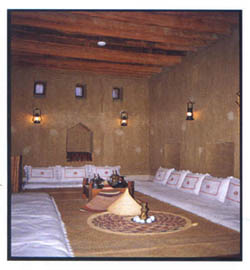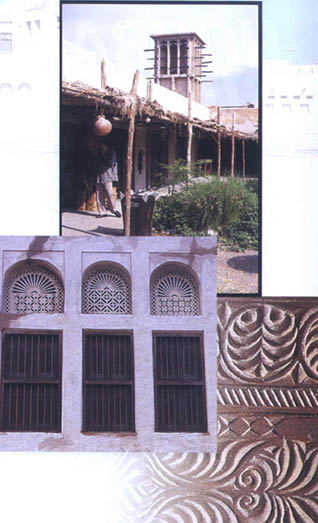|
In
the twenty years that I have lived here, I
have seen a complete change in attitude
towards "old UAE". Just after
the tremendous economic boom that followed
the discovery of oil, people only wanted
to see new buildings, new gadgets, new
cars, everything new and shiny and modern.
I remember trying to take a photograph
once of an old windtower house, when the
inhabitants came out to shoo me away. When
I asked why, they said that their house
was old and ugly and they did not want it
photographed. In those days it was left to
a handful of Emirati to preserve the old
ways of living and farming as a hobby and
a few Western expatriates to renovate
derelict windtower houses.
Fortunately, this has changed. Old things
have become valuable again. They are now
seen as heritage.
Unfortunately, very few of the old
neighbourhoods are still intact. At first
there were only a few small heritage
villages in the rural parts of the
country. There was one next to the ancient
mosque at Bidiya on the East coast that
featured a few huts with household
utensils and animal shelters, while the
showpiece was a 'shasha', an old rowing
boat made of the midribs of palm trees.
Another early heritage village was
adjacent to the Hili gardens in Al Ain,
which was later extended and improved.
After the successful renovation of Sheikh
Saeed's House in Shindagha, it became
apparent that there was a huge interest in
the history of this country among
visitors. During one of the early shopping
festivals a small heritage and diving
village was created in Shindagha. This has
grown over the years into an extensive
exhibition of old buildings, shops and
businesses, where older people show the
younger generations what life was like in
the days of their youth.
Recently the government built another
heritage village - this time in the
countryside, in Hatta. An entire old
village was reconstructed between the old
Hatta towers. Those towers were built
around 1880 from mountain rocks and mud
bricks. They feature entrances that are
2.5 meter above ground, you entered via a
rope. The tower that is included in the
village now has a staircase going up.
Strolling through the village gives a
person quite a good idea what it was like
in those days.
Crossing a 'maidan', where people used to
meet and talk, sitting on wooden benches
below a large tree, you reach the fort. It
is not clear whether this fort is a
renovated old fort or a completely new
reconstruction of a fort. The effect is
the same - it shows the place where the
people of the village could find refuge in
case of attack and where they would come
to meet the local sheikh. The wooden gate
is elaborately carved and gives access to
a large courtyard between fortified walls.
On the left immediately after the entrance
is the 'majlis', a long room with
comfortable cushions along the walls, lit
by small, high windows and burning lamps.
As in all old buildings, the width of the
rooms was limited by the length of the
wooden beams that were used to support the
roof. These beams would be made either of
palm tree trunks or mangrove tree trunks.
In either case they rarely exceed three or
four meters. So most rooms are long and
narrow.
 On the other side of the gate were the
living quarters - small bedrooms with
small four-poster beds and some storage
space. A staircase leads up to the main
defense tower. The lower room in the tower
houses a collection of interesting old
arms, mainly guns. Lifelike mannequins
crouch by the slit windows to fire at the
enemy. Another staircase leads to the top
of the tower that provides a good view
across the adjacent palm groves and
valleys.
On the other side of the gate were the
living quarters - small bedrooms with
small four-poster beds and some storage
space. A staircase leads up to the main
defense tower. The lower room in the tower
houses a collection of interesting old
arms, mainly guns. Lifelike mannequins
crouch by the slit windows to fire at the
enemy. Another staircase leads to the top
of the tower that provides a good view
across the adjacent palm groves and
valleys.
A farmhouse has been reconstructed just
opposite the fort. The courtyard is
spacious, formed by several buildings in
stone as well as a 'barasti' (palmfrond)
kitchen and open-fronted animal shelters.
Another house shows how juice was
extracted from dates. The harvested dates
were placed on a ribbed floor and the
weight of the bunched dates forced the
juice out of the fruit, so that it ran
through the gullies between the ribs to a
collection point. In an adjacent school
building, a teacher sits reading the Quran
to some boys. Further on animal shelters,
a roofed market place and a house that has
an exhibit of products derived from the
palm tree line the path that leads up to
the original old tower.
The buildings are all made with the
original materials. The palm tree played a
major role in the construction of the old
dwellings and outhouses. The dried leaves
('areesj' or 'barasti') were tied together
with rope made of palm tree fiber. This
fiber is harvested from the place along
the trunk where the old leaves have been
cut down. It is twirled into strong rope
and used for many purposes. A frame of
strong palm leaf midribs was tied together
with intricate knots, and the 'barasti'
was attached to these frames. In this way
a shelter was made that allowed the breeze
to play through the leafy cover, while
providing shade from the hot sun. One of
the structures showed that graceful
pillars were made by placing many midribs
parallel to one another to form a round
bunch, which was then wound with many
strands of rope.
During the recent Eid celebrations, Hatta
heritage village was the site for a
cultural show. Local villagers are
involved in these exhibitions and shows.
Twenty-two year old Ali Mattar, who lives
in Hatta, was present every day to teach
young boys how to dance the 'Rasfah' - a
dance which has 2 lines of boys and men
waving staffs and chanting patriotic
poems. Ali said: "The purpose of
doing this is to keep our grandfather's
legacy going. I watched and learned from
my father, he from his father."
Several local women were conducting
open-air cookouts and selling local
delicacies such as 'muhala' and ' chubab'.
Other women showed off their weaving and
plaiting skills as they made the colorful
'machabe' - a conical hat to cover food -
and the 'sarrood' - the round mat that
covers the floor as a kind of table cloth.
Others were adept at constructing baskets
and fans. On display were the large round
all-purpose baskets ('al jefir') and the
smaller round basket for preserving dates
('al yerat') as well as the basket with
long handles that are used to collect the
dates from the trees ('al mukhrafa')
There was also a souvenir shop doing brisk
business selling pottery, rugs, date honey
and other items. The village is quite
extensive and it takes time to see
everything. The one non-traditional thing
that spoiled the day for me was the fact
that much of the walkway was paved with
uneven rocks that made the going
difficult, so that you could not look
around without the fear of tripping. It
did not look authentic and it could easily
be the cause of a sprained ankle or worse.

Recently another heritage village was
opened in Masafi - a completely private
initiative of UAE national Ali Al Ghumaish.
Since many years Al Ghumaish collected
traditional household and farming tools,
which are put on display in 'areesj' (palm
frond) or 'al sha'r' (animal skin)
reconstructed abodes.
"Visitors can see how the handicrafts
are made and how traditional cuisine is
cooked. They can relax in the large
Bedouin tent and enjoy traditional Arab
hospitality. They can get a feel of the
traditional atmosphere and enjoy the 'sheesha'
(water pipe) and 'qahwa' (traditional Arab
coffee)", says Ali. The Masafi
complex is surrounded by lush gardens that
feature a waterfall.
In Ras al Khaimah, a heritage centre was
set up by a local youth club, while in
Fujeirah the government converted a park
adjacent to the old fort into a heritage
village with the usual 'areesj' houses.
But here the centre piece of the
exhibition is the well with the
water-hauling system in which a bull is
led down a steeply inclined ramp, while
hauling a goatskin full of water from the
depths of the well to the top, where the
water is dumped either into containers or
into the 'falaj' (irrigation channel)
system that provides the fields with
water.
All in all the heritage centres
fulfill an important role in keeping alive
the days of old that were otherwise only
recorded in rare black and white
photographs.
|
